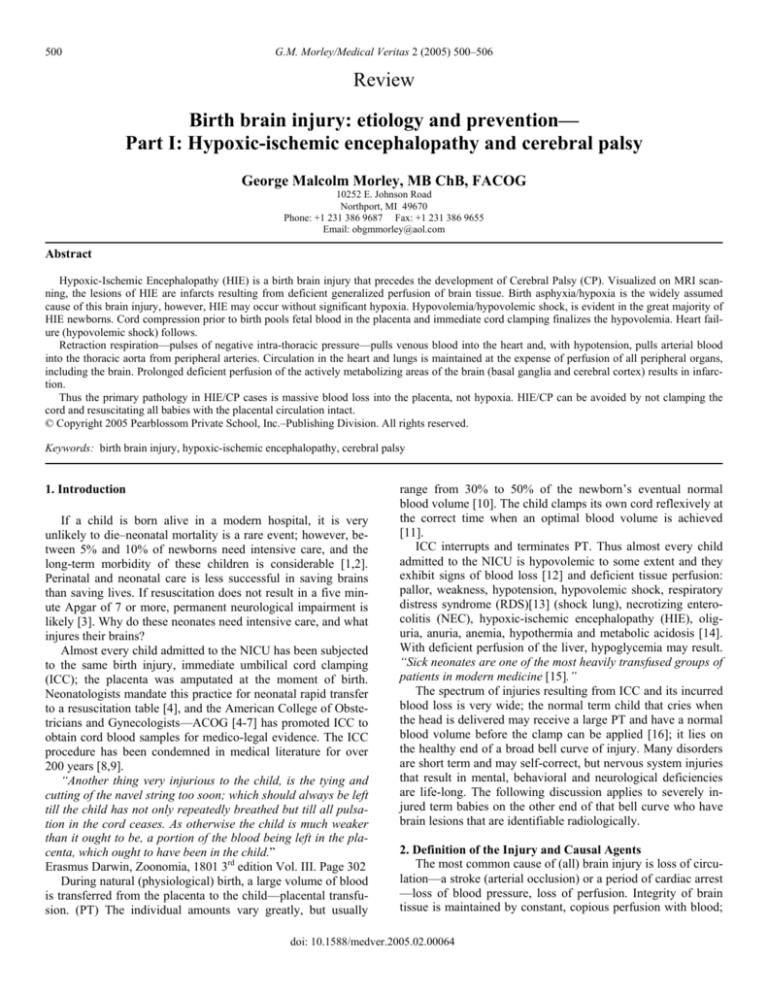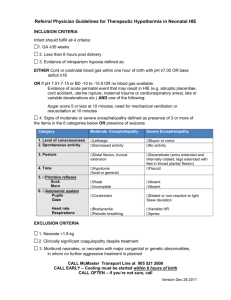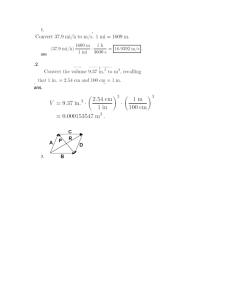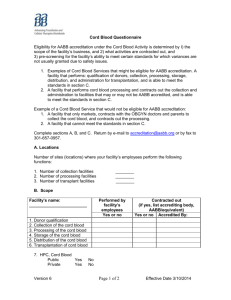
G.M. Morley/Medical Veritas 2 (2005) 500–506
500
Review
Birth brain injury: etiology and prevention—
Part I: Hypoxic-ischemic encephalopathy and cerebral palsy
George Malcolm Morley, MB ChB, FACOG
10252 E. Johnson Road
Northport, MI 49670
Phone: +1 231 386 9687 Fax: +1 231 386 9655
Email: obgmmorley@aol.com
Abstract
Hypoxic-Ischemic Encephalopathy (HIE) is a birth brain injury that precedes the development of Cerebral Palsy (CP). Visualized on MRI scanning, the lesions of HIE are infarcts resulting from deficient generalized perfusion of brain tissue. Birth asphyxia/hypoxia is the widely assumed
cause of this brain injury, however, HIE may occur without significant hypoxia. Hypovolemia/hypovolemic shock, is evident in the great majority of
HIE newborns. Cord compression prior to birth pools fetal blood in the placenta and immediate cord clamping finalizes the hypovolemia. Heart failure (hypovolemic shock) follows.
Retraction respiration—pulses of negative intra-thoracic pressure—pulls venous blood into the heart and, with hypotension, pulls arterial blood
into the thoracic aorta from peripheral arteries. Circulation in the heart and lungs is maintained at the expense of perfusion of all peripheral organs,
including the brain. Prolonged deficient perfusion of the actively metabolizing areas of the brain (basal ganglia and cerebral cortex) results in infarction.
Thus the primary pathology in HIE/CP cases is massive blood loss into the placenta, not hypoxia. HIE/CP can be avoided by not clamping the
cord and resuscitating all babies with the placental circulation intact.
© Copyright 2005 Pearblossom Private School, Inc.–Publishing Division. All rights reserved.
Keywords: birth brain injury, hypoxic-ischemic encephalopathy, cerebral palsy
1. Introduction
If a child is born alive in a modern hospital, it is very
unlikely to die–neonatal mortality is a rare event; however, between 5% and 10% of newborns need intensive care, and the
long-term morbidity of these children is considerable [1,2].
Perinatal and neonatal care is less successful in saving brains
than saving lives. If resuscitation does not result in a five minute Apgar of 7 or more, permanent neurological impairment is
likely [3]. Why do these neonates need intensive care, and what
injures their brains?
Almost every child admitted to the NICU has been subjected
to the same birth injury, immediate umbilical cord clamping
(ICC); the placenta was amputated at the moment of birth.
Neonatologists mandate this practice for neonatal rapid transfer
to a resuscitation table [4], and the American College of Obstetricians and Gynecologists—ACOG [4-7] has promoted ICC to
obtain cord blood samples for medico-legal evidence. The ICC
procedure has been condemned in medical literature for over
200 years [8,9].
“Another thing very injurious to the child, is the tying and
cutting of the navel string too soon; which should always be left
till the child has not only repeatedly breathed but till all pulsation in the cord ceases. As otherwise the child is much weaker
than it ought to be, a portion of the blood being left in the placenta, which ought to have been in the child.”
Erasmus Darwin, Zoonomia, 1801 3rd edition Vol. III. Page 302
During natural (physiological) birth, a large volume of blood
is transferred from the placenta to the child—placental transfusion. (PT) The individual amounts vary greatly, but usually
range from 30% to 50% of the newborn’s eventual normal
blood volume [10]. The child clamps its own cord reflexively at
the correct time when an optimal blood volume is achieved
[11].
ICC interrupts and terminates PT. Thus almost every child
admitted to the NICU is hypovolemic to some extent and they
exhibit signs of blood loss [12] and deficient tissue perfusion:
pallor, weakness, hypotension, hypovolemic shock, respiratory
distress syndrome (RDS)[13] (shock lung), necrotizing enterocolitis (NEC), hypoxic-ischemic encephalopathy (HIE), oliguria, anuria, anemia, hypothermia and metabolic acidosis [14].
With deficient perfusion of the liver, hypoglycemia may result.
“Sick neonates are one of the most heavily transfused groups of
patients in modern medicine [15].”
The spectrum of injuries resulting from ICC and its incurred
blood loss is very wide; the normal term child that cries when
the head is delivered may receive a large PT and have a normal
blood volume before the clamp can be applied [16]; it lies on
the healthy end of a broad bell curve of injury. Many disorders
are short term and may self-correct, but nervous system injuries
that result in mental, behavioral and neurological deficiencies
are life-long. The following discussion applies to severely injured term babies on the other end of that bell curve who have
brain lesions that are identifiable radiologically.
2. Definition of the Injury and Causal Agents
The most common cause of (all) brain injury is loss of circulation—a stroke (arterial occlusion) or a period of cardiac arrest
—loss of blood pressure, loss of perfusion. Integrity of brain
tissue is maintained by constant, copious perfusion with blood;
doi: 10.1588/medver.2005.02.00064
G.M. Morley/Medical Veritas 2 (2005) 500–506
the lesion produced by deficient perfusion is an infarct—dead
tissue. Hypoxic-ischemic encephalopathy, (HIE) the precursor
of cerebral palsy (CP), is visualized in the neonate using MRI
scanning. Necrosis of brain tissue (infarction) is evident mainly
in areas of high metabolic activity—the basal ganglia, the cerebral cortex and, in the preemie, the germinal matrix. The
ischemia is generalized, not confined to an arterial distribution
area [17]; these infarcts occur and progress after birth regardless
of the oxygen content of the blood.
3. Hypoxia
Hypoxia/asphyxia is generally assumed to be the “cause” of
brain damage, and brain damage (identical to HIE/CP) is readily produced in newborn primates by asphyxiation [18,19]. Babies that develop HIE are usually born “asphyxiated” [20], and
ACOG [7] “strongly supports the concept that a neonate who
had hypoxia prior to delivery severe enough to result in HIE
will show other signs of hypoxic damage including all the following:
1. Cord arterial blood pH <7
2. Apgar 0-3 at 5 minutes
3. Neurological sequelae and [multi organ dysfunction]”
However, in a very comprehensive study on the timing of
HIE, Cowan [17] contradicts ACOG, stating: “there is no evidence that brain damage occurs before birth.” However,
Cowan’s criteria for the clinical definition of HIE:
1. Abnormal tone
2. Feeding difficulties
3. Altered alertness
Plus three or more of the following: (a) late decelerations,
(b) delayed respiration, (c) cord pH < 7.1, (d) Apgar scores < 7
at five minutes, and (e) multi-organ dysfunction—implicate
some degree of hypoxia or an “insult” near the time of birth.
Cowan’s first three (mandatory) criteria for HIE eerily echo old
descriptions of the immediately clamped child [21].
501
HIE demonstrated on MRI may develop without evidence of
significant hypoxia [17]. Neonates with HIE are routinely oxygenated after birth. For the past 30 years, asphyxiated (fetal
distress) babies have increasingly been rapidly diagnosed, rapidly delivered and rapidly oxygenated and intensively cared for.
The incidence of CP has remained constant at about 1-2 per
1000 births for 30 years; correction and prevention of hypoxia
does not appear to be very beneficial in preventing CP.
On closer examination of the asphyxiated experimental animal [19] (Figure 1), the primary lethal effect of asphyxia is cardiac arrest—the heart needs oxygen to beat and to generate
blood pressure—after loss of blood pressure, brain infarction
occurs and generalized infarction follows. If an “asphyxiated”
child is born with a pulsating cord, the heart is receiving enough
oxygen to perfuse itself and the placenta; the heart should also
be perfusing and oxygenating the brain. Why then, after birth,
with the heart beating and the lungs supplying oxygen, does
HIE begin and progress? The fetal brain grows and develops
while copiously perfused with blood that is not fully saturated
with oxygen. Despite ACOG’s concept [7], hypoxia cannot be
the major factor in neuron necrosis; what, then, is the origin of
the ischemia in HIE?
4. Ischemia
Figure 1 illustrates the progress of an asphyxiated newborn
monkey [19], cord clamped, trachea occluded. The heart fails
from lack of oxygen and the BP falls eventually to zero—
cardiac arrest—and brain damage ensues. During heart failure,
gasping occurs and has a significant effect on cardiac function.
With “gasps” there are spikes of increased pulse rate (increased
cardiac output.) At the same time, there are downward spikes of
diastolic blood pressure to the zero line (decreased cardiac output!) After resuscitation (ventilation with oxygen) and adrenaline injection there is rapid recovery; then the BP again falls
and gasping returns persistently. Hypoxia does not cause this
gasping.
Figure 1. Heart rate and blood
pressure changes (top) and gasp
pattern (bottom) associated with 25
minutes of total asphyxia in Term
Fetus 1735. Fifteen minutes of resuscitation are also represented.
The gasp pattern is identifiable in
the cardiotachometer and blood
pressure recordings as well as in
the bar graph. Efforts at cardiac
massage during the 26th and 27th
minutes also appear. Epinephrine,
0.1 mg, was injected intra-arterially
at the beginning of resuscitation
during the 26th minute. Gasping
reappeared during the 5th minute of
resuscitation. Reprinted with permission. Myers RE. Two patterns
of perinatal brain damage and their
conditions of occurrence. Am J of
Obstet and Gynecol, 1972 Jan 15;
[Figure 1] 112(2):247.
doi: 10.1588/medver.2005.02.00064
502
G.M. Morley/Medical Veritas 2 (2005) 500–506
Note that the cord was clamped immediately at birth; the
heart rate (and cardiac output) fell immediately by 50% in response to abrupt, total loss of oxygen supply and decreased
venous return. A large amount of blood volume was clamped in
the placenta.
Gasping is retraction respiration (RR) and is a reflexive response to cardiac failure/low blood pressure/low central venous
pressure. It causes pulses of high negative pressure in the thorax
that draw venous blood into the right heart and the lungs, and
into the left heart if the foramen ovale is open – note pulse-rate
spikes. With hypotension, it also pulls arterial blood back into
the thoracic aorta from peripheral arteries—note collapses of
peripheral diastolic blood pressure to zero or below zero. During gasps, blood may be drained from the brain arteries, and
cerebral circulation may become tidal—it may virtually cease.
The net effect of RR is to maintain some circulation and blood
volume in the heart and lungs at the expense of all peripheral
organs – multi-organ dysfunction [22].
5. Heart Failure: Hypoxic and Hypovolemic
The term “heart failure” means that the heart is not generating an adequate blood pressure. In Figure 1, gasping is first
caused by hypoxic heart failure. After resuscitation, the animal
(revived from “death”) is well oxygenated, but when the pulmonary circulation fills with blood, (ventilation dilates pulmonary arterioles) the BP collapses and heart failure with gasping
recurs—a major portion of the blood volume was clamped in
the placenta at birth. This hypotension / heart failure is hypovolemic in origin, not hypoxic. In this particular monkey, the
hypovolemic heart failure was not progressive; the animal
adapted to moderate hypovolemia with generalized vasoconstriction. RR in an oxygenated human neonate is a sign of hypovolemic heart failure requiring immediate blood volume replacement; persistent RR with progressive hypotension will
result in cerebral ischemia and possible brain damage.
Thus hypovolemia/hypovolemic shock (rather than hypoxia)
is a much more probable and more plausible cause of the metabolic acidosis, low Apgar scores, multi-organ dysfunction and
HIE that ACOG assumes to be hypoxic damage [7]. ACOG
specifically mentions hypoxic gastro-intestinal injury and renal
dysfunction [7]. However, in the fetus, the gut and kidneys are
perfused with the same hypoxic blood that is going to the placenta to be oxygenated! With adequate perfusion, the gut and
kidneys grow and thrive on this hypoxic blood supply; with
inadequate perfusion/hypovolemic shock, regardless of oxygenation—infarction occurs—renal cortical necrosis and NEC.
In this hypovolemic situation, especially if the child is “retracting,” the brain is also very susceptible to infarction. In the adult
during terminal hypovolemic shock or heart failure, gasping or
RR is termed “air hunger.”
tory distress syndrome (RDS, RR) and a low 5-minute Apgar
score. Cord compression during birth—a tight nuchal cord
[23,24], a firm, true knot, or a prolapsed cord – is the most
common cause of birth asphyxia / fetal distress. Cord compression does much more than asphyxiate the fetus.
Intra-partum cord compression acts as a venous tourniquet
with umbilical arteries engorging the placenta while the compressed vein allows a minimal amount of oxygenated blood to
flow back into the child—producing prolonged or late decelerations on the FHR monitor. (See Fig. 2 and Cowan’s criteria.)
Cord compression thus produces fetal hypoxia and fetal hypovolemia—the fetal blood volume shifts to the placenta. [23,
14] Linderkamp [24] terms this “Intra-partum Asphyxia.”
Eventually, placental engorgement increases umbilical venous
pressure that overcomes compression; oxygen return to the fetus improves and the “fetal distress” appears to be relieved.
However, the placenta remains engorged, the child remains
very hypovolemic and it may be in shock [12,16,23]. In the
extreme, the child is born ashen pale, “dish-rag” limp with peasoup meconium; most of its blood volume is in the placenta.
The routine neonatal management of this child is ICC followed
by immediate ventilation.
7. Hypovolemia in Extremis
Unlike the monkey fetus in Figure 1, the cord-compressed
human fetus is hypovolemic before and at birth, [23] and ICC
removes a massive portion of feto-placental blood volume.
What little blood that is left in the child may flow into the
lungs, but the peripheral circulation then collapses. Five minutes of intensive resuscitation (intubation, oxygenation, central
venous lines, arterial lines, dopamine) may produce a fiveminute Apgar below 7, and the child will enter the NICU oxygenated, but with marginal vital signs. If intravenous fluids
maintain tissue perfusion, the child may stabilize; not infrequently, the child stops breathing, and frantic resuscitation occurs with mechanical ventilation. Then, hours after birth, the
child convulses, announcing the onset of HIE, and the brain is
treated with phenobarbital. Two or three weeks after birth, the
hemoglobin is 10 gm% confirming that the child lost 50+% of
its blood volume at birth, and red cell transfusion [15] is given.
“Nelson and colleagues have noted that a tight nuchal cord was
seen at delivery significantly more often in infants with neonatal encephalopathy than in controls [17].”
Hypoxia caused by cord compression entails, even guarantees hypovolemia; the fetal oxygen supply is dissolved in blood.
ACOG’s concept of fetal “hypoxia severe enough to result in
HIE” thus implies the tandem concept of fetal “hypovolemia
severe enough to result in HIE.” To avoid hypovolemic injury,
immediate blood volume replacement is needed, not oxygen.
8. Physiological Resuscitation with Placental Transfusion
6. Intra-partum Hypoxia/Intra-partum Hypovolemia
Despite some pallor, most normal, term babies seem to adjust to blood loss caused by ICC [10]. However, in the “high
risk” “asphyxiated” depressed, term baby, the sequence of ICC
at birth, delayed breathing, with hasty resuscitation and ventilation often results in hypotension, generalized weakness, respira-
The only way to avoid the above scenario is to resuscitate
with the placental circulation intact; do not clamp the cord
[10, 14]. A nuchal cord should never be clamped and cut. If it
cannot be reduced over the head or the shoulder, allow delivery
to proceed while manipulating the head and neck towards the
vulva and unwind the cord after delivery. Position the child
doi: 10.1588/medver.2005.02.00064
G.M. Morley/Medical Veritas 2 (2005) 500–506
below the level of the placenta for gravity placental transfusion.
With cord compression relieved, (release the nuchal cord,
loosen the firm knot) massive placental transfusion replaces the
child’s blood volume, establishes copious pulmonary blood
flow and perfuses/oxygenates all vital organs. Within a minute
or two, neonatal cardiovascular hemodynamics are restored to a
normal, healthy status.
The tracing of Figure 2 was discovered twenty minutes after
it occurred. It continued with good FHR variability but with
503
minor late decelerations, never below 100 BPM. Occult cord
prolapse was found at C-section and the child (no meconium)
was pale and somewhat limp at birth; cord pulsation was vigorous, the lips and mucous membranes were purple. Intravenous
oxytocin was given to the mother to contract the uterus to hasten placental transfusion. The child was breathing at one minute
and was crying, squirming and ruddy pink (no pallor) at four
minutes when cord pulsations ceased. The cord was then
clamped and cut. Five minute Apgar score ten.
Figure 2. A prolonged fetal heart rate deceleration typical of the initial incidenct of cord compression showing progressive bradycardia as hypoxia increases. (A) severe hypoxia with FHR below 60 bpm. (B) then gradual relief of hypoxia as placental venous pressure
increases to overcome the compression after the arteries engorge the placenta. (C & D)
The cord-compressed, “asphyxiated” neonate has an enormous
resuscitation potential stored in the placenta that will nearly
always guarantee full recovery if the cord is not clamped; the
abruption placenta neonate and Linderkamp’s “intrauterineasphyxia” fetus [24] do not possess this advantage.
Figure 3. Rapid Cesarean section delivery of an asphyxiated monkey fetus. During delivery and intubation, severe bradycardia and
hypotension developed. However, with 100% oxygen ventilation, the heart rate and blood pressure again increased toward normal
values. Umbilical cord clamping after resuscitation led to a sudden jump in the mean blood pressure (from 65 to 74 mm Hg). Printed
with permission. Myers RE. Two patterns of perinatal brain damage and their conditions of occurrence. Am J Obstet Gynecol, 1972
Jan 15; [Figure 16] 112(2):262
doi: 10.1588/medver.2005.02.00064
504
G.M. Morley/Medical Veritas 2 (2005) 500–506
9. Abruptio Placenta: Pure Asphyxia
Placental abruption removes placental respiration; this is
pure hypoxia/asphyxia without blood volume shifting. Myers‘
Figure 16 (3) [19] shows the effects of pure asphyxia. The
mother was breathing nitrogen and the falling fetal heart rate
indicates the increasing hypoxia while the cord remains unclamped. Despite the increasing hypoxia, the BP never fell to
the extent shown in Figure 1, but it would have done so if delivery and resuscitation had not intervened. The second half of
the tracing confirms the value of resuscitation with the placental
circulation intact [10,14]. The pulse rate and the blood pressure
recover, and, in marked contrast to Figure 1, the pulse rate and
blood pressure increase when the cord is eventually clamped –
after the lung vessels filled with placental blood. This monkey
(+cord +placenta) always had a normal, ample blood volume
with continuous tissue perfusion despite hypoxia; it also had no
brain damage.
If delivery had not occurred, hypoxic heart failure would
have ensued together with gasping, and the general pattern of
Figure 1 would have been repeated. Severe brain ischemia (five
minutes or more of zero BP will suffice) would produce brain
infarction in utero—similar to the monkey in Figure 1. This
situation comes close to concurring with ACOG’s concept of
hypoxia causing HIE, but heart failure and loss of perfusion
actually produce the brain infarcts, hypoxia (extreme) causes
the heart failure.
If abruption babies can be delivered and resuscitated with
the placenta still attached before they are markedly “depressed,”
they should recover well. If they are born limp and a-reflexic,
they do not have a large reservoir of oxygenated blood in the
placenta to rescue their brains—that may be already damaged.
Anecdotally, several neonatologists have mentioned that the
depressed abruption neonate is the least likely to respond well
to resuscitation, implying that ante-partum brain damage has
already occurred.
If cord compression is strong enough to occlude all the cord
vessels, the child is in the same situation as the complete abruption baby—rapid anoxic heart failure, brain death and demise
follow soon. This may occur in cord prolapse when the cord is
outside the vulva. Once the cord reaches the atmosphere, water
evaporates from Wharton’s jelly and the cord cools rapidly. All
the cord vessels respond to cold with constriction and closure.
Most cord prolapse cases that present with an exteriorized cord
produce a stillborn. If the cord is still pulsating, replacement in
the warm, moist vagina and prompt c-section may save the
child’s life.
10. Intra-Uterine Asphyxia/Oligohydramnios
Linderkamp described the “intrauterine asphyxia fetus” [24]
as exhibiting a shift of blood volume from the placenta to the
fetus. This situation happens in oligohydramnios; the cord is not
“cushioned” by fluid and the umbilical vein becomes generally
compressed. As in acute cord compression, the placenta becomes engorged and chronic placental capillary hypertension
results. This forces fluid from the fetus into the maternal circulation and the whole feto-placental unit becomes progressively
dehydrated.
In the extreme, there is generalized vasoconstriction of placenta, cord and fetus, loss of interstitial fluid, severe hemoconcentration to the point of hypovolemia, oliguria and/or anuria.
At birth, the cord vessels may appear as three “pencil strings” in
Wharton’s jelly. There is no placental transfusion available.
This is the perfect “hyperviscosity syndrome [16].”
Today this situation seldom occurs; ultrasound diagnoses
and amnio-infusion corrects the pathology and the child is
rarely born “in extemis.” If it is, the clinical assessment and
management should be based on the condition of the cord.
“Pencil strings” should be clamped and cut immediately and
catheters placed for immediate replacement of fluid and correction of acidosis by the neonatologist. If there is palpable cord
pulsation with the FHR above 100 bpm and the vein is filled,
try to allow the placental circulation to restore hydration, maintain life support and supply what placental transfusion may be
available during the third stage while pulmonary resuscitation
continues. Bradycardia is an indication for clamping and cutting
the cord to give rapid IV fluid replacement.
The only other situations that justify clamping a pulsating
cord are spontaneous cord rupture at birth and incision of an
anterior placenta previa at cesarean section. Plasma volume
expanders should be used liberally in such cases, and preservation of placental blood for autologous transfusion should be
attempted.
11. Discussion
Current neonatal resuscitation [4] – ICC and immediate ventilation—violates the most basic concept of rational medical
care—restoration of normal form and function without harm. If
a child is born depressed—obviously incapable of spontaneous
breathing – the condition is not due to failure of its lungs, but to
dysfunction of organs and systems that are needed to initiate
spontaneous breathing—usually the cord and placenta. If the
cord is pulsating, the dysfunction is not total—the cord and
placenta are keeping the child alive; placental/cord function
should be maintained and restored, not amputated, to maximize
recovery of the child.
This principle is used to correct fetal distress in utero—
changing the mother’s position, or giving amnio-infusion to
relieve cord compression, or elevating the presenting part from
a prolapsed cord. After birth, during the third stage of labor, use
of this principle is essential in successfully “reviving” the depressed newborn; it permits the normal, orderly process of transition from placental life support to activation of the neonate’s
own organs of life support. If an apneic neonate’s cord is beating at 100+ bpm, the child has an adequate placental oxygen
supply; it is not asphyxiated. The color of mucus membranes
will be purple, not pink, due to fetal circulation. Cord clamping
creates rapid, total asphyxia.
In the apneic newborn, ICC precipitates panicked ventilation
to reverse the iatrogenic total asphyxia. If the child does not
have sufficient blood volume to perfuse the ventilated lungs and
convert the fetal circulation to the adult, the asphyxia will not
be reversed. During physiological birth, placental blood volume
is transfused to the lungs, and after ventilation and establishment of lung function, oxygenated blood flows through the umbilical arteries—they respond with constriction and closure.
doi: 10.1588/medver.2005.02.00064
G.M. Morley/Medical Veritas 2 (2005) 500–506
Physiology thus maintains placental respiration until pulmonary
respiration is well established; there is no period of asphyxia in
physiological transition, and there is no hypovolemia.
ACOG’s experimentation with ICC [5, 6] may be in demise;
ACOG quietly withdrew bulletins 216 and 138 from publication
in 2001 and 2003 following publication [25] and exposure [26]
of ICC’s injurious effects. However, ACOG Bulletin 303 still
mentions cord arterial pH as an evaluation tool. ACOG has not
issued any caution regarding ICC, yet ICC, required to procure
cord arterial blood samples, correlates strongly with the development of HIE and CP in “asphyxiated” neonates [17,20,
27,28]. The Cochrane Review [4] advises that delayed clamping
be employed to avoid brain damage in preemies. Parents have
been advised not to use aspirin on children because of occasional correlation with the brain damage of Reyes’ syndrome.
The comparative risks of ICC surely need mention.
The perinatal professions have never performed a random,
double blind, controlled, scientific study that compares the results of feto-placental physiology during the third stage of labor
(no cord clamp used) with the results of immediate iatrogenic
destruction of the umbilical circulation with a cord clamp. Yet
amputation of the functioning placenta remains routine, standard care, with major Neonatology (Educational) publications
stating, “For most term or near term infants, the time of cord
clamping may not matter [4].” Meanwhile, the American Academy of Pediatrics (AAP) advises that delayed cord clamping be
used to avert the need for blood transfusion, and NeoReviews
[4] advises that the obstetrician “wait a minute” before amputating the preemie’s placenta to avoid brain damage. The procedure of ICC with rapid ventilation is very difficult to justify;
clamping a pulsating cord is also very difficult to justify.
The above, proposed random study would never occur; it
requires the legal informed consent of the parents. Once legally
informed (full disclosure) [29] about ICC, parents will opt for
non-random alternative care. The ethical physician/midwife
should be readily available.
Many, if not most midwives, especially with out-of-hospital
deliveries, routinely delay cord clamping and cutting until the
placenta is delivered. The apocryphal complications of physiological cord closure—hyperviscosity, [16] polycythemia, plethora [16] and jaundice [4] do not fill NICUs with home birth
babies. In every other aspect of medical practice, physiology is
maintained and restored. Third stage neonatal/cord/placental
physiology is misunderstood, ignored, disrupted and destroyed;
the consequences of that ignorance fill NICUs. An informed
consent document, [29] signed by doctor/midwife/parents, that
defines why, when and whether the cord should be clamped,
should restore perinatology to objectivity and reason.
12. Conclusion
The large majority of HIE/CP babies result from ICC performed on an already hypovolemic infant that has suffered cord
compression during birth. Brain damage is ischemic in origin
and occurs after birth as a result of hypotension/hypovolemic
heart failure usually compounded by retraction respiration.
HIE/CP in these neonates is preventable by not clamping the
pulsating cord and by resuscitation with the placental circulation intact. Placental transfusion restores normal perfusion of
505
the infant’s life-support organs. In a minority of cases, such as
total abruption of the placenta, HIE/CP may occur prior to birth
caused by anoxic heart failure—and may be unavoidable. Routine care at every delivery should include not clamping the umbilical cord until pulsations have ceased and until the child is
breathing and pink.
Conclusion by email
Hi Dr. Morley, I just did a birth yesterday that was a perfect
example of your theory, (one which I have followed for 25
years). I had a 40 year old primip with a long but normal labor
and with good FHR throughout until a sudden drop at crowning, down to 60 with no return to baseline, after a quick episiotomy and quick birth the baby had already entered 2nd apnea, I
saw it “gasp” before the head was born. The baby had a nuchal
cord as well as a true knot! She came out in a flood of thick
meconium that she had inhaled during her birth. No pulse was
palpable at birth but with the cord intact the pulse quickly came
up to normal (Apgars 2, 7, 9) and with a lot of suctioning and
her parents touching her and talking to her and her cord pulsating with a little bag and mask she is fine and now fully up to
“normal” newborn status. When I think back to how this situation would have been handled in places where I have worked (I
work in an out-of-hospital birth center now) I know this baby
would have ended up in the NICU with mec pneumonia, the
cord would have been cut, the neonatologists would have
“saved” the baby, and who knows where the child would end up
years later. Tracey A., CNM
Addendum—Retraction Respiration: A Simulation.
Retraction respiration is widely regarded as the significant
sign of neonatal respiratory distress. To have retraction respiration redefined as the significant sign of hypovolemic shock and
heart failure, without any pulmonary patho-physiology, will, no
doubt, give rise to some controversy.
The causality of ischemic lesions that result from sudden,
severe, neonatal episodes of negative intra-thoracic pressure
will be equally controversial. The following adult simulation of
retraction respiration should clarify resolution of these disputes.
While recording the radial pulse rate, breathe out fairly completely, then close the mouth and one nostril; inspire vigorously, maintaining the effort until the lungs are filled with air.
The radial pulse disappears during forceful inspiration.
Two mutual factors combine to produce this temporary “cardiac arrest:”
1. High negative intra-thoracic pressure counteracts thoracic aortic blood pressure.
2. High negative intra-thoracic pressure pulls blood into the
pulmonary veins from the left atrium, preventing ventricular filling and briefly stopping cardiac output.
In a person with a normal blood volume and normal blood
pressure, recovery is almost instantaneous, and the long “gasp”
is harmless; but in a neonate with a systolic blood pressure of
50 mm Hg, with a very deficient blood volume and with a marginal cardiac output, repeated “gasping” every ten to twenty
seconds will remove a significant portion of blood volume from
systemic organ perfusion; retraction respiration thus becomes a
very plausible cause of ischemic injury.
doi: 10.1588/medver.2005.02.00064
506
G.M. Morley/Medical Veritas 2 (2005) 500–506
References
[1] Hack M, Flannery DJ, Schluchter M, Cartar L, Borawski E, Klein N.
Outcomes in young adulthood for very low birth-weight infants. New
Engl J Med, 2002 Jan;346(3):149–57.
[2] Goldenburg RL. The management of preterm labor (an expert’s view).
Obstet Gynecol, 2002 Nov;100(5 Part 1):1020–37.
[3] Thorngren-Jerneck K, Herbst A. Low 5-minute Apgar score: a population
based register study of one million term births. Obstet Gynecol, 2001;
98(1):1024–6
[4] Philip AGS, Saigal S. NeoReviews, April 2004;5(4):e150. Available
online at http://neoreviews.aappublications.org/cgi/eletters/5/4/e142#73
[5] ACOG Committee Opinion Number 138, April 1994, published in the
International Journal of Gynaecology and Obstetrics, 2000;45:303–4 [54],
2002, reaffirmed 2000, and listed as current in Obstet Gynecol, Feb. 2002.
[6] American College of Obstetricians and Gynecologists. Umbilical Artery
Blood Acid-Base Analysis. Washington, D.C.: ACOG; 1995. Educational
Bulletin 216.
[7] ACOG Committee Opinion #303, Obstetrics & Gynecology; 104(4):903–
4.
[8] White C. A Treatise on the Management of Pregnant and Lying. In:
Women, 1773.
[9] Williams JW. Obstetrics: A Text-Book for the Use of Students and Practitioners, 4th ed., 1917:342–3.
[10] Peltonen T. Placental Transfusion, Advantage—Disadvantage. Eur J Pediatr, 1981;137:141–6
[11] Gunther M. The transfer of blood between the baby and the placenta in the
minutes after birth. Lancet, 1957;I:1277-1280.
[12] Faxelius G, Raye J, Gutberlet R, Swanstrom S, Tsiantos A, Dolanski E,
Dehan M, Dyer N, Lindstrom D, Brill AB, Stahlman M. Red cell volume
measurements and acute blood loss in high risk infants. J Pediatrics 1977;
90(2):273–81.
[13] Landau DB. Hyaline membrane formation in the newborn: hematogenic
shock as a possible etiological factor. Missouri Med, 1953; 50:183.
[14] Morley GM. Neonatal Resuscitation: Life that Failed. Obgyn.net Available
online at http://www.obgyn.net/pb/pb.asp?page=/pb/articles/neonatalresuscitation
[15] Murray NA, Roberts IAG. Neonatal transfusion practice. Arch. Dis. Child.
Fetal Neonatal Ed., 2004 Mar; 89: F101–7.
[16] Morley GM. Cord closure: can hasty clamping injure the newborn? Obg
Management, July 1998; 29–36.
[17] Cowan F, Rutherford M, Groenendaal F, Eken P, Mercuri E, Bydder GM,
Meiners LC, Dubowitz LM, de Vries LS. Origin and timing of brain lesions in term infants with neonatal encephalopathy. The Lancet, 2003
Mar;361(9359):736–42
[18] Windle WF. Brain damage by asphyxia at birth. Scientific American,
1969; 221(4):76–84.
[19] Myers RE. Two patterns of perinatal brain damage and their conditions of
occurrence. American Journal of Obstet Gynecol, 1972; 112:246–76.
[20] Hankins GD, Koen S, Gei AF, Lopez SM, Van Hook JW, Anderson GD.
Neonatal organ system injury in acute birth asphyxia sufficient to result in
neonatal encephalopathy. Obstetrics & Gynecology, 2002 May; 99(5 part
1):688–91.
[21] Lusk WT. The science and art of midwifery. New York: D Appleton and
Company, 1882:214–5 “Infants which have had the benefit of late ligation
of the cord are red, vigorous, and active, whereas those in which the cord
is tied early are apt to be pale and apathetic.” “Much weaker than it ought
to be.” Erasmus Darwin. 1801.
[22] Shah P, Riphogen J, Beyene J, Perlaman M. Multiorgan Dysfunction in
Infants with Post-asphyxial Hypoxic Ischaemic Encephalopathy. Arch Dis
Child Fetal Neonatal Ed, 2004;89;F152–5. Available online at http://fn
.bmjjournals.com/cgi/eletters/89/2 /F152#434
[23] Cashmore J, Usher RH. Hypovolemia resulting from a tight nuchal cord at
birth. Pediatr. Res, 1973;7:339.
[24] Linderkamp O. Placental transfusion: determinants and effects. Clinics in
Perinatology, 1982;9:559–92.
[25] Morley GM. Mode of delivery and risk of respiratory disease in newborns.
[Letter] Obstet Gynecol, 2001 June; 97(6):1025–6.
[26] Morley GM Letter: Don’t clamp cords. Mothering Magazine; May/Jun
2003.
[27] Williams K., Singh A. The correlation of seizures in newborn infants with
significant acidosis at birth with umbilical artery cord gas values. Obstet
Gynecol, 2002 Sep;100(3):557–60.
[28] Hankins GD, Erickson K, Zinberg S, Schulkin J. Neonatal encephalopathy
and cerebral palsy: A Knowledge Survey of Fellows of the American College of Obstetricians and Gynecologists. Obstet Gynecology, 2003;
101(1):11–7.
[29] Ethics in Obstetrics and Gynecology Second Edition. The American College of Obstetricians and Gynecologists, 2004. Informed Consent; 9–17.
doi: 10.1588/medver.2005.02.00064







